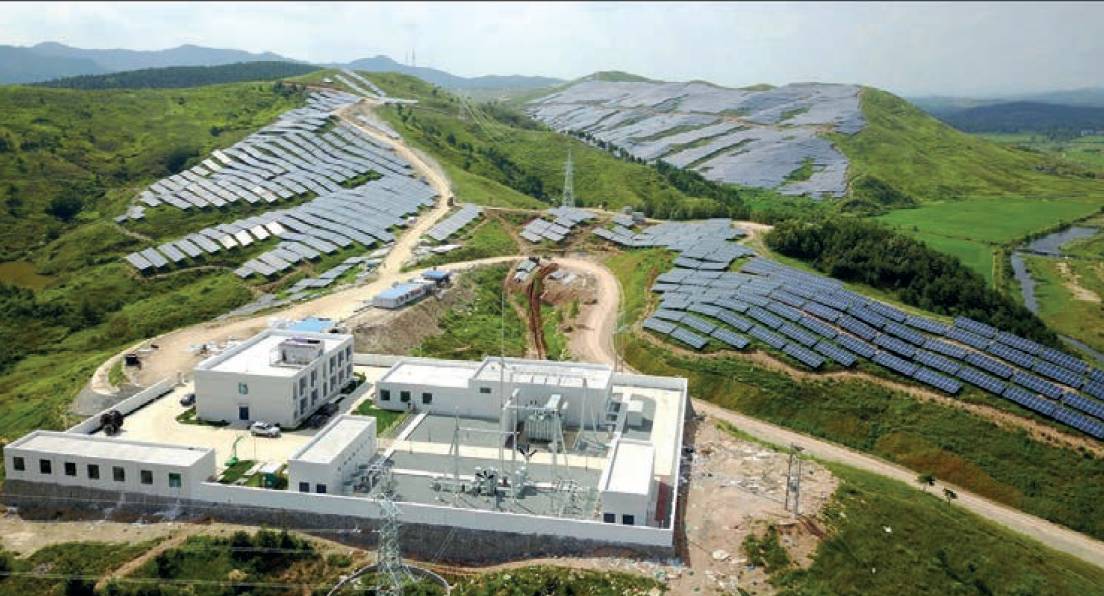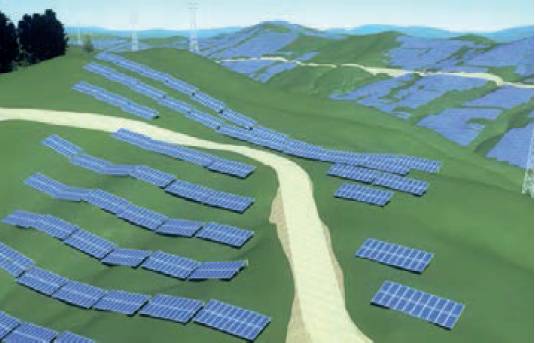Transitioning China to clean energy
Richard Irwin, Bentley Systems

A digital twin helped detect and resolve clashes. Picture credit: POWERCHINA Hubei Electric Engineering Co.,., Ltd.

CHINA has been a world leader in renewable energy growth, accounting for 40% of the world’s renewable energy development from 2015 to 2020. The country works to shift away from fossil fuels by instituting corporate mandates and directing the People’s Bank of China to provide low-cost funding to lenders that contribute to green projects. The objective is to generate a combined 1,200 gigawatts of wind and solar energy by 2030.
China wants to transition a full 80% of its energy mix to renewables by 2060. To help meet the country’s goals, POWERCHINA Hubei Electric Engineering undertook the design and construction of an 80-megawatt groundbased photovoltaic power station near Guangshui in the Hubei province.
The design team soon ran into several challenges while developing in the region, which is dominated by hills, pine woods, and fishponds. A location had to be chosen carefully so that it could accommodate 14,080 solar panels while minimising the impact on the environment and local wildlife. Once the site was selected, the design of the photovoltaic array, booster station, access road, and transmission line had to be optimised to suit the widely varying topography of the area.
Specifically, the design would need to shorten the length of the road, reduce the size of the booster station, and maximise the daily amount of electricity generated by each component. Even with the demands of the project, POWERCHINA Hubei still had to carefully control costs.
Struggling with inadequate software
POWERCHINA Hubei determined that digital design would help in the selection of an optimal location for the power station, then place all components around the environment.
The design would need to shorten the length of the road, reduce the size of the booster station, and maximise the daily amount of electricity generated by each component.
A third-party design software was initially selected for the job, however, it was soon realised that the complexities of the project overwhelmed this software. All potential sites for the station were covered in low hills and steep slopes, often with gullies and hollows between them.
As a result, the supports needed to be modified for every one of the thousands of components for them to fit in the irregular terrain. Every solar panel needed a different angle and spatial position based on the ground elevation and the potential shading. The considerable size of the facility, and the large number of solar panels, added up to a massive number of individual adjustments that were difficult to make using previous software.
Adding to the problems, the design showed that the engineering quality of the cabling, from the individual panels to the booster station to the transmission line, was difficult to control. It was decided that burying the cabling would protect them from regular wear and to lessen the ongoing impact to the environment. Yet the undulating environment also made the cabling process difficult, and the original software was not able to help ensure a suitable layout.
Though the team initially attempted to create the design of the entire power station in the initial software, it could not easily handle the large number of complex tasks and significantly slowed the process. To avoid falling behind the project’s strict 10-month deadline, the team decided to switch to a series of applications that would support its goals.

Planning every construction step using 3D models. Picture credit: POWERCHINA Hubei Electric Engineering Co.,., Ltd.
Automating solar panel placement on complex terrain
All potential sites for the station were covered in low hills and steep slopes, often with gullies and hollows between them. As a result, the supports needed to be modified for every one of the thousands of components for them to fit in the irregular terrain.After a brief search, POWERCHINA Hubei determined Bentley’s applications would allow the client to fully model the fine details of the complex project while meeting the required deadline. ProjectWise was selected to create a connected data environment, enabling all contributors to collaborate on the design.
A reality mesh of the project environment was imported into MicroStation and OpenBuildings, which then performed a full terrain analysis to determine how to design and adjust individual components.
Using the applications, specific software was developed that could help to quickly design solar fields in mountains. Once base 3D models of the solar array were created, the software could be used to automate the placement and angle of each of the 14,080 solar panels in and around the hills, keeping total shading on the project at any given time below 2% and guarantee maximum exposure to sunlight.
With the solar panels in place, POWERCHINA Hubei used OpenBuildings Designer to design the booster station and OpenUtilities Substation to determine the cabling layout and design the transmission line.
With the help of OpenUtilities, it was determined how to effectively bury the cables under the hills while minimising the disruption to the area. With a completed digital twin of the entire development, SYNCHRO was used to determine the most efficient construction schedule possible, which helped the client improve construction management.
Improving construction with clear intent and scheduling
With the help of a digital twin created with Bentley applications, POWERCHINA Hubei optimised both the design and construction of the power station. Integrating all elements into a federated model helped to shrink the footprint of the booster station to just 1,181m2 2 and reduce the length of the access road by 4km. Models could be automatically generated and placed within the digital twin, compared to manually creating the elements.
China wants to transition a full 80% of its energy mix to renewables by 2060.Custom software for automating the placement and angle of solar panels kept panel shading below 2%, which maximises daily electrical production. Working within the single digital twin allowed for the detection and resolution of clashes that would have resulted in around 40 instances of rework and in turn saved 20 days of construction. The amount of cabling needed was also reduced due to careful planning within the digital model, all of which saved time and money.

Picture credit: POWERCHINA Hubei Electric Engineering Co.,., Ltd.
Throughout the development process, the digital model reduced design errors and the need for manual verification, resulting in a more efficient design. POWERCHINA Hubei then put the digital twin to work during construction with SYNCHRO 4D. Planning every step of the process, using the 3D models to communicate the design intent with contractors, and incorporating augmented reality technology accelerated construction by 30 days while avoiding any accidental panel shading.
The power station is now operational and delivering renewable energy to Hubei. POWERCHINA Hubei subsequently worked with Bentley to establish the China Power Engineering Software Research and Development Centre, which expands upon the techniques used in the Guangshui project and enhances the organisation’s ability to offer integrated digital solutions across the lifecycles of future solar power stations.
Richard Irwin, Bentley Systems
POWERCHINA Hubei Electric Engineering Co., Ltd.’s Wuhan Xudong 220kV substation project is a finalist of Bentley’s 2022 Going Digital Awards In Infrastructure finalists. The project is one of the finalists in the grid category. The awards will take place on 15 November in London.